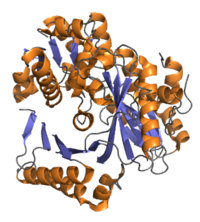
Photo from wikipedia
Tropisetron exerts a protective effect against cardiac complications, particularly cardiac hypertrophy. Oxidative stress and apoptosis are the main contributors to the pathogenesis of cardiac hypertrophy. Sirtuins, a family of histone… Click to show full abstract
Tropisetron exerts a protective effect against cardiac complications, particularly cardiac hypertrophy. Oxidative stress and apoptosis are the main contributors to the pathogenesis of cardiac hypertrophy. Sirtuins, a family of histone deacetylases, are connected to cellular oxidative stress signaling and antioxidant defense. Sirtuins are also linked to apoptosis which is an important mechanism in the progression of cardiac hypertrophy to heart failure. Literature also suggests that tropisetron impedes apoptosis, partly mediated through an antioxidant mechanism. Therefore, we examined if tropisetron fights cardiac hypertrophy by adjusting sirtuin family proteins (Sirts) and components of mitochondrial death pathway, Bcl-associated X (BAX), Bcl-2-associated death promoter (BAD). Male Sprague-Dawley rats got divided into four groups, including control (Ctl), tropisetron (Trop), cardiac hypertrophy (Hyp), and hypertrophic rats under tropisetron treatment (Hyp + Trop). Pathological cardiac hypertrophy was induced by surgical abdominal aortic constriction (AAC). The increased expression of brain natriuretic peptide (BNP) in the Hyp group confirms the cardiac hypertrophy establishment. The mRNA levels of SIRT1, SIRT3, SIRT7, and BAD also upregulated in the hypertrophic group (p < 0.001). Postoperational administration of tropisetron for 3 weeks lowered the increased expression of BNP (p < 0.05) and BAD (p < 0.001), though the reduction of BAX expression was statistically insignificant (p > 0.05). Tropisetron treatment also restored the normal level of SIRT1/3/7 genes expression in the Hyp + Trop group (p < 0.05). Present findings suggest that tropisetron can suppress cardiomyocyte hypertrophy progression to heart failure by counteracting BNP, SIRT1, SIRT3, Sirt7, and BAD overexpression-mediated apoptosis in a rat model of cardiac hypertrophy.
Journal Title: Journal of biochemical and molecular toxicology
Year Published: 2023
Link to full text (if available)
Share on Social Media: Sign Up to like & get
recommendations!